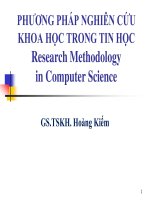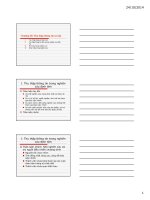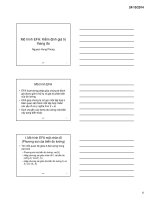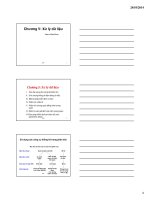Bài thi Phương pháp Nghiên cứu khoa học
Bạn đang xem bản rút gọn của tài liệu. Xem và tải ngay bản đầy đủ của tài liệu tại đây (53.76 KB, 15 trang )
Assignment requirements
Name:
Class:
Subject: Research Methodology
Topic: An investigation into the motivation of non-native English
speaking employees working for foreign companies in Ho Chi
Minh city to upgrade their English level as L2 adult learners
CONTENT
I.
Rationale
It is interesting to note that adult learning theories have been
largely absent from mainstream research into L2 motivation,
despite a great proportion of L2 learners being adults. While the
key theoretical models and frameworks in L2 motivation research
are not age-specific, they have been chiefly validated by studies
conducted with learners in schools and universities. This literature
review argues that adult motivation to learn and participate in
learning presents characteristics worth investigating and bringing
into the broader scholarly debate on L2 motivation.
II.
Aim of the study
The aim of this research was to explore the motivation of adult
course and, more specifically, to uncover the factors which the
participants perceived as key in shaping and sustaining their
motivation during a nine-month period.
Although a study of this kind was never designed to identify
correlations between motivational variables and retention rates, it
was believed that it might help to shed light on the factors
contributing to the completion of a beginner FL course by adult
learners when others fail to do so.
III.
Research questions
Following on from the research aim, the study set out to address
three main questions:
How do adult L1-English learners view their motivation during
a beginner‟s FL course?
2
What factors do they perceive to be motivationally significant
at different stages of the course and overall?
In their view, how do the above account for their completion of
the course and for their wish to carry on learning the language?
The above research questions encapsulate what Mason (2002)
describes as “the intellectual puzzle” (p.19) which, in my case,
developed during a ten year period of teaching Italian in adult and
higher education. The puzzle began to emerge as a series of
simple questions, which many reflexive teachers of adults are
likely to ask themselves at some point: What makes adult
language learners tick? What is it that drives some to return week
after week when so many drop out, particularly in the early stages
of learning a language?
Seeking clarity in the L2 motivation research literature led,
instead, to further questions and problematizing. For instance,
could existing L2 motivation theories explain the dynamics of FL
3
learning motivation in adults? How did foreign language
motivation differ from second language motivation? In terms of a
comprehensive theory, would Gardner‟s concept of
integrativeness be relevant to my students or would Dörnyei‟s L2
Motivational Self-system be more widely applicable? Should the
answer be found in the cognitive, in the affective domain or
elsewhere altogether? It soon became apparent that it would be
beyond the scope of this research to explore a large number of
issues in any depth. Nevertheless, the fundamental question of
what generates and, above all, sustains the motivation of adults on
a FL beginners‟ course from their perspective, has remained the
central focus of this study.
In formulating aims and questions, care was taken to avoid
variable and causative relationships, which research of this type
cannot attempt to make. Instead, the study set out to describe,
explore and ultimately interpret and understand the participants‟
stories and experiences. The next sections discuss the choices of
4
research paradigm, research type and tradition employed by the
study.
IV.
Scope of the study
In order to select participants for the pilot study, an invitation
letter was sent via email to 50 English major and non-English
Vietnamese employees (aged between 17 and 21 years), inviting
them to take part in the survey questionnaire and focus groups. A
total of 13 students (7 English major and 6 non-English major)
who agreed to take part in the pilot study were selected, as it is
recommended that the translated survey instruments need to be
piloted with a group of between three to ten people who are as
close to the future participants as possible (Beauford, Nagashima,
& Wu, 2011). This group of participants had similar
characteristics to the participants of Studies 1 and 2 in that they
are Vietnamese, fell within the same age range (aged from17-21
years), and were studying English. Most importantly, they were
able to comment on the wording of the translated scales. After
5
completion of the questionnaires, these participants also took part
in the focus groups. Litosseliti (2003)
postulates that a focus group can be conducted with between three
and ten people. For the purposes of the focus group in the pilot
study, 7 English major students were allocated in one group and 6
non-English major students were asked to work in another group.
V.
Methods of Study
Development of Research Paradigms in L2 Motivation
Research
Locating this Research Program as Mixed Methods Research
This present research used mixed methods to answer five
research questions:
RQ1. What types of motivation do English major and nonEnglish major students report when they are learning English in
higher education in Vietnam?
RQ2. What are the similarities and differences in motivation
between English major and non-English major students?
6
RQ3. What are the similarities and differences in their levels
of motivational intensity, autonomy, competence and relatedness
between English major and non-English major students?
RQ4. What are the relationships between motivation and
motivational intensity, autonomy, competence and relatedness for
English major and non-English major students?
RQ5. In what ways do lecturers, peers and parents influence
Vietnamese students’ motivation to learn English?
VI.
Tentative Design of the Study
Stage Participant Data Collection Purposes
Procedure of
s
Data
s
Instruments
Collection
Pilot Thirteen
21-item
Study Vietnames Language
To pilot the
Translated
translated
questionnaire
e emploees Learning
questionnaire in was
who were Orientation
order to ensure
administered
working in Scale- Intrinsic the equivalence to employees
Ho Chi
Motivation,
of the translated Discussions
7
Minh City Extrinsic
questionnaire and with
Motivation and the original
employees
Amotivation
about the
questionnaire
Subscales
wording of
(LLOS ̶ IEA)
the
(Noels et al.,
questionnaire
2000)
were
10-item
conducted
Motivational
Intensity Scale
(Gardner, 2010)
12-item Basic
Psychological To pilot the
Needs Scale
interview
(Carreira, 2012) procedure in
order to refine
Semi-structured the focus group
questions (focus questions
8
Guided
questions
used in the
groups
focus groups
were asked
and refined
for later use in
Study 2
Study 422
21-item
To identify the
Online
1
second-
Language
types of
questionnaire
year
Learning
motivation
was sent to
reported by
empolyees
employees Orientation
Scale- Intrinsic employees
Motivation,
To explore the
Extrinsic
similarities and
Motivation and differences in
Amotivation
types of and
Subscales
levels of
(LLOS ̶ IEA)
motivation
(Noels et al.,
between
2000)
employess
9
10-item
To investigate the
Motivational
differences in the
Intensity Scale level of
(Gardner, 2010) motivational
12-item Basic
intensity, self-
Psychological perceptions of
autonomy,
Needs Scale
(Carreira, 2012) competence and
relatedness
between
employees
To examine the
relationships
between different
types of
motivation and
motivational
intensity,
10
autonomy,
competence and
relatedness
Study 36
2
Semi-structured To explore why Before each
employees focus group
employees were focus group
who
studying English began
questions
completed
and if they
the
differed in their were asked to
questionna
motivation to
ire were
learn English (to written
asked to
verify the finding response to a
take part in
in Study 1)
number of
two focus
To explore
questions
groups (six
employees’
which were
employees
perceptions of
further
in each
how parents,
discussed in
11
participants
provide a
focus
teachers and
the focus
group)
peers influence
group
their motivation Guided
questions
were asked to
facilitate
focus group
discussions
Focus groups
were
conducted in
Vietnamese
The Pilot Study had two objectives: (1) to pilot the translated
questionnaires and (2) to pilot the focus group questions. As the
participants of the program of research were employees, the
questionnaire was translated into Vietnamese. The translated
questionnaire was piloted with a small number of participants in
order to get their feedback on accuracy, clarity and cultural
12
appropriateness of all items in the translated questionnaire. The
issues relating to instrument translation, participant selection and
the procedure of the pilot study are discussed later in this chapter.
Study 1 sought to answer RQs 1 ̶ 4. In order to address these
research questions, a questionnaire made of three measures was
employed as the data collection instruments. A detailed
explanation of each measure used in Study 1 occurs later in this
chapter.
Study 2 aimed to provide more explanation for RQ1, RQ2, and
explored perceived influences that their lecturers, peers and
parents have on their motivation, which addresses RQ 5. Study 2
collected qualitative data by means of focus groups and students’
written responses to a number of questions. The original
qualitative data were in Vietnamese, which were then translated to
English for analysis.
VII.
Outline of Literature Review
Chapter 1: Introduction
Overview.............................................................................................
13
Globalisation and English Teaching and Learning in Higher
Education in Vietnam..........................................................................
Chapter 2: The Broader Context of Vietnam
Overview.............................................................................................
Vietnam: The Land, History, People and Culture
Chapter 3: Motivation to Learn a Second Language
Chapter 4: Research Design
Chapter 5: Study 1
Chapter 5: Study 1
VIII. References
Richards, J. C. (2005). Communicative language teaching
today. Cambridge: Cambridge University Press.
Rigby, C. S., Deci, E. L., Patrick, B. C., & Ryan, R. M. (1992).
Beyond the intrinsic- extrinsic dichotomy: Self-determination in
motivation and learning.
Motivation and Emotion, 16, 165-185. doi:
10.1007/BF00991650
Ronnås, P., & Sjöberg, Ö. (1991). Economic reform in Vietnam:
Dismantling the centrally planned economy. The Journal of
14
Communist Studies and Transition Politics, 7(1), 7-19. doi:
10.1080/13523279108415069
Ruesch, A., Bown, J., & Dewey, D. P. (2012). Student and
teacher perceptions of motivational strategies in the foreign
language classroom. Innovation in Language Learning and
Teaching, 6(1), 15-27. doi:10.1080/17501229.2011.562510
Ryan, R. M. (Ed.). (1991). The nature of the self in autonomy
and relatedness. New York: Springer.
Ryan, R. M., & Connell, J. P. (1989). Perceived locus of
causality and internalization: examining reasons for acting in two
domains. Journal of Personality and Social Psychology, 57(5),
749-762. doi: 10.1037/0022- 3514.57.5.749
15









